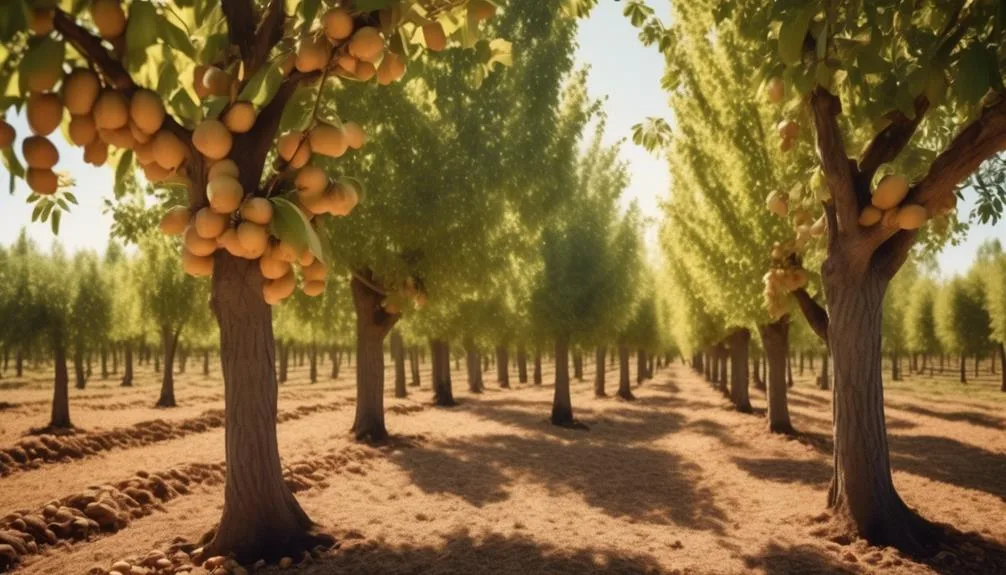To get the best harvest from hickory trees, where you plant them matters. Factors like soil, sunlight, and climate impact nut production. Understanding these can make a big difference.
Let's explore how these factors affect hickory trees and their nut yield.
Soil Requirements
To ensure successful growth and nut production, hickory trees thrive in well-drained soil with a slightly acidic to neutral pH level. The pH levels are crucial as they affect nutrient availability to the trees.
Compacted soil can hinder the growth of hickory trees, so it's important to ensure proper drainage and avoid soil compaction. Well-drained soil prevents water from accumulating around the roots, preventing root rot and other water-related issues.
Additionally, the slightly acidic to neutral pH level promotes the availability of essential nutrients for the trees, aiding in their growth and nut production.
When planting hickory trees, it's essential to assess the soil's drainage and pH levels to provide the best environment for the trees to thrive and produce an abundant harvest of nuts.
Sunlight Needs
Hickory trees require full sunlight for optimal growth and nut production, thriving in at least six hours of direct sunlight per day. When considering the sunlight needs of hickory trees, it's essential to ensure they're planted in an area that receives abundant sunlight throughout the day.
To ensure the health and productivity of your hickory trees, consider the following:
- Pruning Techniques: Regularly prune your hickory trees to remove any dead or diseased branches, promoting better air circulation and sunlight exposure.
- Watering Schedule: Maintain a consistent watering schedule, ensuring that the soil is kept consistently moist, especially during hot and dry periods.
- Pest Control: Implement pest control measures to protect your hickory trees from common pests that can affect their growth and nut production.
- Disease Prevention: Regularly inspect your trees for signs of disease and promptly address any issues to prevent the spread of diseases.
- Sunlight Exposure: Monitor the sunlight exposure of your hickory trees to ensure they're receiving the necessary amount for optimal growth and nut production.
Spacing and Arrangement
When selecting the spacing and arrangement for your hickory trees, consider the mature size of the trees and their potential impact on neighboring vegetation and structures.
Hickory trees, especially nut tree varieties, require ample space to spread their branches and develop a healthy root system. For optimal nut production, allow at least 30 to 40 feet between each hickory tree to ensure they've enough room to grow without competing for resources.
Proper spacing also facilitates air circulation, reducing the risk of diseases and promoting overall tree health.
Additionally, consider the arrangement of your hickory trees to maximize sunlight exposure and airflow. Pruning techniques can also be used to manage the shape and size of the trees, ensuring that they don't overcrowd each other and allowing for easier nut harvesting.
Climate Considerations
Considering the impact of your hickory trees' spacing and arrangement, it's crucial to also factor in the climate considerations that will directly affect their growth and nut production. When choosing the right location, keep in mind the temperature tolerance and rainfall preferences of hickory trees. Here are some key climate considerations to keep in mind:
- Temperature Tolerance: Hickory trees thrive in temperate climates, with most varieties being cold hardy and able to withstand winter temperatures. However, some species may have specific temperature requirements, so it's essential to choose a location that aligns with your hickory tree's temperature preferences.
- Rainfall Preferences: Hickory trees generally prefer well-drained soil and moderate to high levels of rainfall. They can tolerate short periods of drought, but consistent moisture is essential for optimal growth and nut production. Ensure that the chosen location provides adequate rainfall or irrigation to support your hickory trees' needs.
Pollination Requirements
To ensure successful nut production, it's important to understand the pollination requirements of hickory trees and how to optimize their pollination process.
Hickory trees benefit from cross-pollination, where the pollen from one tree fertilizes the flowers of another. Cross-pollination increases genetic diversity and nut production. It's essential to have different hickory tree varieties nearby to facilitate this process.
Additionally, cross-pollination often results in more uniform nut size and better overall nut production. Without cross-pollination, there may be variations in nut size, which can affect the commercial value and overall quality of the nuts.
Therefore, when planting hickory trees for nut production, consider the benefits of cross-pollination and ensure that different varieties are in close proximity to maximize nut size and production.
Conclusion
With the right conditions and careful consideration of climate and pollination needs, planting hickory trees in your yard can lead to a bountiful harvest of delicious nuts.
By ensuring the proper soil, sunlight, and spacing, you can look forward to enjoying the rewards of a thriving hickory tree in your own backyard.
Happy planting!

My interest in trees started when I first saw the giant sequoias in Yosemite.
I was a teenager then, and I remember thinking, “I need to learn more about this.”
That moment stuck with me.
A few years later, I went on to study forestry at Michigan Tech.
Since graduating, I’ve worked in a mix of hands-on tree care and community education.
I’ve spent over ten years helping people understand how to plant, maintain, and protect the trees in their neighborhoods.
I don’t see trees as just part of the landscape.
They are living things that make a real difference in our daily lives.
